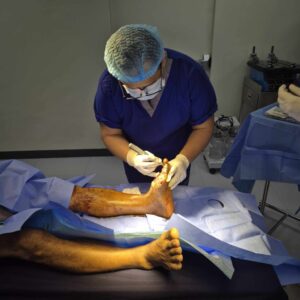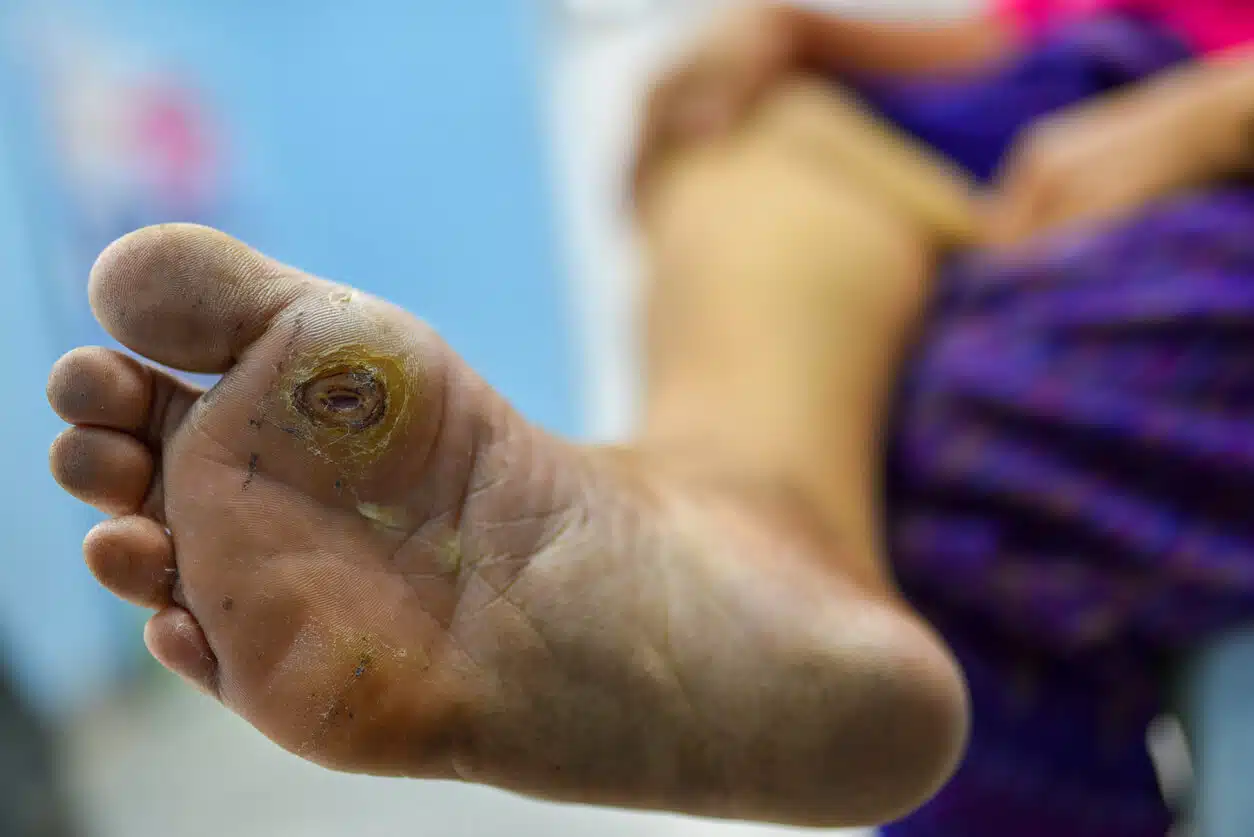Diabetic foot ulcers are open sores or wounds that usually develop on the bottom of the feet in individuals with diabetes. These ulcers are caused by a combination of high blood sugar levels, poor circulation, and nerve damage, which make the feet more vulnerable to injuries. Since many people with diabetes experience reduced sensation in their feet, small cuts or blisters may go unnoticed and gradually worsen into larger wounds. Left untreated, these ulcers can lead to infections that may threaten overall health. Understanding how they form and progress is the first step in effective care. People living with diabetes must be aware of even minor changes in their feet, as early detection significantly improves outcomes. This condition requires continuous vigilance and proper management to prevent complications.
Causes and Risk Factors
There are multiple reasons why people with diabetes are more likely to develop foot ulcers. One major factor is poor circulation, which slows down the natural healing process and reduces the body’s ability to fight infection. Nerve damage, or diabetic neuropathy, plays a big role as well, as it diminishes sensation and makes it harder for individuals to notice injuries. Additionally, high blood sugar levels impair the immune system, making it more difficult to control bacterial growth around wounds. Wearing improper footwear, walking barefoot, or experiencing frequent foot pressure can also contribute to ulcer formation. People who smoke, are overweight, or have kidney or heart disease are at an even higher risk. Recognizing these factors helps in creating strategies to reduce their impact. Without this awareness, small wounds can escalate quickly and become severe.
Importance of Early Detection
Detecting diabetic foot ulcers at an early stage can make a huge difference in treatment success. A wound that is caught early is far easier to manage and less likely to develop into a severe infection. Patients should check their feet daily for redness, swelling, blisters, or any unusual changes. Something as minor as a corn or callus can develop into a serious ulcer if neglected. Routine check-ups with a healthcare provider also play a crucial role, as a professional can detect issues patients might overlook. Early detection reduces the risk of hospitalization, surgery, and even amputation. It also minimizes the emotional and financial stress that comes with advanced complications. Establishing a daily foot inspection routine is one of the most powerful tools for prevention.
Medical Approaches to Diabetic Foot Ulcers Treatment
Modern medicine offers a wide range of effective approaches for treating diabetic foot ulcers. Wound debridement, a process where dead or infected tissue is carefully removed, allows healthy tissue to grow and encourages faster healing. Antibiotics may be prescribed to fight infections that often accompany ulcers. Specialized dressings are used to keep wounds moist and clean, preventing further irritation. In severe cases, surgery may be needed to remove infected bone or tissue. Doctors may also recommend offloading, which involves reducing pressure on the ulcer by using crutches, special shoes, or casts. These methods, when combined, provide patients with a structured pathway toward healing. Every treatment plan is personalized depending on the patient’s overall health and the severity of the ulcer.
Innovative and Advanced Therapies
Beyond standard treatments, advanced medical techniques are transforming the way diabetic foot ulcers are managed. Hyperbaric oxygen therapy has gained attention because it increases oxygen supply to the wound, accelerating healing. Skin grafts and bioengineered tissue products can also replace damaged skin and encourage new tissue growth. Negative pressure wound therapy uses a vacuum dressing to promote blood flow and remove excess fluid, which enhances healing. Researchers are exploring regenerative medicine techniques that may further improve outcomes in the future. These innovations are giving patients new hope by providing solutions for ulcers that don’t respond to traditional methods. Although some of these therapies may not be widely available everywhere, they represent the future of diabetic wound care. Patients are encouraged to discuss advanced options with their healthcare providers to see if they are suitable candidates.
Home Care and Daily Management
Managing diabetic foot ulcers does not end at the hospital or clinic—it continues at home every single day. Patients are advised to follow strict wound care routines, which include cleaning and properly dressing wounds under medical supervision. Blood sugar control is crucial, as high glucose levels slow healing and make infections more likely. Protective footwear or orthotics should be worn to minimize pressure on the ulcer and prevent further damage. Hygiene is equally important, and feet should be washed daily with mild soap and warm water, followed by thorough drying, especially between the toes. Regularly moisturizing dry skin can also reduce the risk of cracks and sores. Home care empowers patients to take charge of their healing process and lowers the likelihood of recurrence. With proper guidance, daily routines can make a significant difference in recovery.
Practical home management tips:
- Wash and inspect feet daily for cuts, blisters, or redness
- Wear protective, well-fitted shoes and cushioned socks
- Avoid walking barefoot indoors or outdoors
- Maintain strict blood sugar control through diet and medication
- Schedule routine foot exams with a podiatrist
Preventive Strategies for Long-Term Foot Health
Preventing diabetic foot ulcers is far easier than treating them. Patients should prioritize regular podiatric visits to monitor foot health and detect early problems. Choosing the right footwear and socks is also key, as ill-fitting shoes can create pressure points that lead to ulcers. Daily self-inspections allow patients to address potential issues before they escalate. Adopting a healthy lifestyle, including a balanced diet, regular exercise, and quitting smoking, significantly lowers the risk of complications. Education is equally important—patients and caregivers should learn proper foot care techniques to avoid unnecessary injuries. Simple changes, like trimming toenails carefully and avoiding harsh self-treatments, can go a long way. Preventive care provides lasting protection against recurrence and helps preserve mobility and independence.
When to Seek Immediate Medical Help
Knowing when to seek urgent medical attention can save lives for individuals with diabetic foot ulcers. Warning signs include increasing pain, spreading redness, swelling, pus drainage, or fever, which may indicate infection. If a wound is not healing after a few days of care, it is essential to consult a healthcare provider immediately. Delaying treatment increases the chances of severe complications, including gangrene and amputation. Patients should never attempt to treat severe ulcers on their own with over-the-counter remedies or home solutions. Emergency care ensures that infections are controlled quickly and proper medical interventions are applied. Caregivers also play a role by encouraging loved ones to seek help when warning signs appear. Acting swiftly protects both health and quality of life.
Frequently Asked Questions (FAQ)
How long does it take for a diabetic foot ulcer to heal?
Healing time depends on the severity of the ulcer, overall health, and treatment methods. Minor ulcers may heal in weeks, while severe cases can take months or longer.
Can diabetic foot ulcers be completely cured?
Yes, with proper medical treatment and strict self-care, ulcers can heal completely. However, recurrence is possible if preventive measures are not followed.
What are the best shoes for people with diabetic foot ulcers?
Diabetic-friendly shoes with extra cushioning, seamless interiors, and wide toe boxes are recommended. Custom orthotics may also be prescribed.
Is surgery always necessary for severe ulcers?
Not always. Many ulcers respond to conservative treatments, but surgery may be necessary if infection spreads to the bone or tissue damage is extensive.
How can I reduce my chances of getting diabetic foot ulcers again?
Regular foot care, proper footwear, daily inspections, and blood sugar control are the most effective strategies to prevent recurrence.
Takeaway
Diabetic foot ulcers treatment requires a comprehensive approach that blends medical care, advanced therapies, home management, and preventive practices. By recognizing risk factors early, committing to daily foot care, and working closely with healthcare providers, patients can greatly improve healing outcomes. With the right combination of vigilance and treatment, diabetic individuals can protect their feet, maintain mobility, and prevent life-altering complications.











